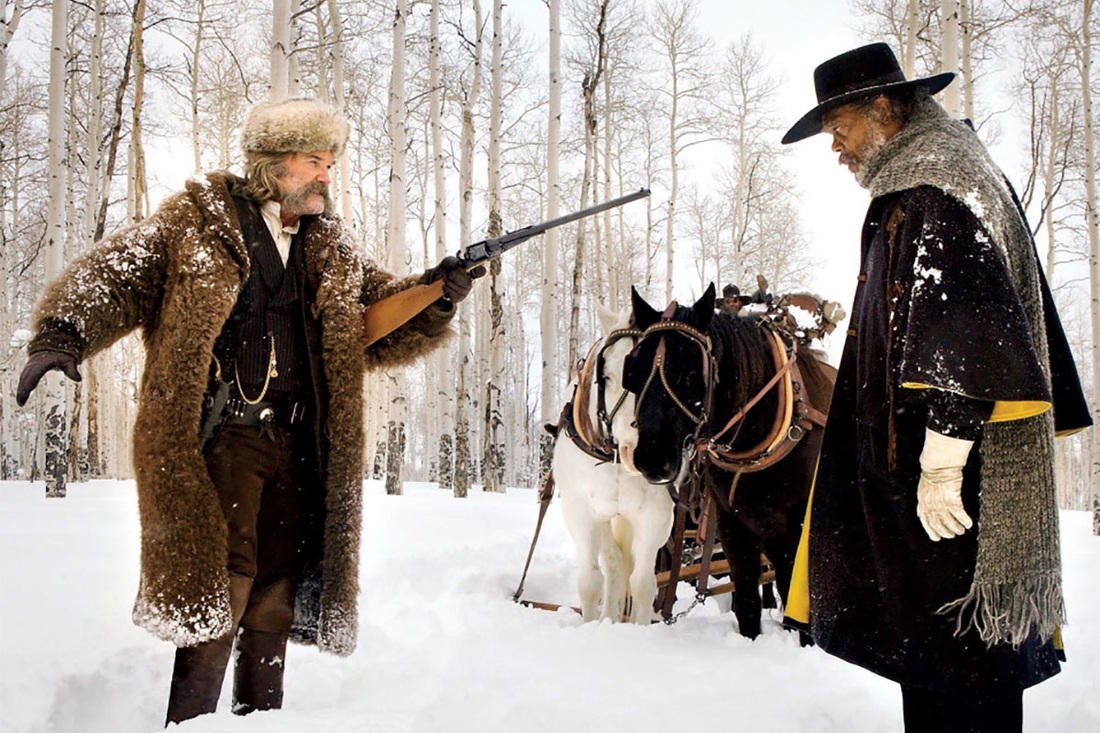Our story begins on a snowy afternoon in Wyoming Territory eight of ten or twelve years after the Civil War. On this winter’s day Major Marquis Warren (Samuel L. Jackson) is bringing some bounty heads in to a town called Red Rock to collect his reward money, but his horse succumbed to the cold. In response, he hails down a passing stage coach whose occupant, John “The Hangman” Ruth (Kurt Russel), happens to be another bounty hunter and an acquaintance of Major Warren’s. He’s also heading to Red Rock, but not with bodies- he’s bringing in a woman named Daisy Domergue (Jennifer Jason Leight) to hang because he always brings in his bounties alive. On the way, they pick up yet another hitch hiker- Chris Mannix (Walton Goggins). Although Warren is hesitant about traveling with the son of a notorious Civil War criminal, Mannix claims to be the new Sheriff of Red Rock, so he and Ruth let him ride with them regardless. But the approaching blizzard prevents the four traveling companions from reaching Red Rock, and instead forces them to stop at a stage coach station called Minnie’s Haberdashery. But rather than encountering the eponymous Minnie, they encounter four strange guests at the establishment: Oswaldo “The Little Man” Mobray (Tim Roth), Joe “The Cow Puncher” Gage (Michael Madsen), General Sandford “The Confederate” Smithers (Bruce Dern), and Bob “The Mexican” (Demián Bichir). But it soon becomes apparent that at least one of these men is not who he says he is, and may in fact be in league with Domergue…
The first thing that’s noticeable about The Hateful Eight is much of a throwback to the classic spaghetti westerns it is. It’s quite long compared to his previous works, either 167 or 187 minutes depending on whether you’re watching the standard version or the roadshow version. Part of this is because of the film’s overture and intermission; I will not talk too much about this since much has already been said elsewhere, but suffice to say it feels odd but somewhat satisfying to have an actual break in the movie where you can talk to your friends, buy some popcorn or use the restroom. Compared to Tarantino’s other works, this film starts off quite slow. The whole first half of the film is basically devoid of any violence, and consists mostly of people talking. Although this does seem odd for a Tarantino film, it does make it more in tune with the epic westerns of days gone by, which typically start off slow and build to an explosive conclusion. Plus, it doesn’t seem as out of place due to the film’s genre, which is actually a cross between the western and a mystery film.
Another thing that’s noticeable about this film is its tone. Most of Tarantino’s more recent works (Django Unchained, Inglorious Basterds, Kill Bill) no matter what genre and style they were, always kind of felt like they were comedies in a way. Despite all the violence that occurred, it was all so over-the-top it always just felt completely ridiculous and was often played for laughs. The Hateful Eight is violent, of course, but the violence is of a different kind. It’s much less stylized and much more real, and much more intense when it does occur in the second half of the film. And although the film does retain Tarantino’s trademark absurdity (one exchange in particular between Major Warren and General Smithers springs to mind…), he uses it less for comedy and more to make the audience feel uncomfortable. The result is a movie that’s much more serious than his past fare; I don’t think it’s a spoiler to say that the ending is tragic. The only one of his previous works that The Hateful Eight seems comparable to is his first film, Reservoir Dogs, which (compared to all the others) is much less played for laughs and much more played for drama and tragedy.
The acting of course is fantastic from everyone in the cast. And the writing is just as brilliant as his other films, if slightly more twisted. But the real star of the show here is the cinematography. Tarantino shot the entire film on 70 mm film, and if you get the chance, make sure to see the roadshow version of the show so you can see it projected off 70 mm film. I know it makes me sound like a pretentious film geek, but the 70 mm really does look so much better than digital. And it makes it feel so much more like those classic westerns of days gone by, which was certainly his true goal. Oh, and last but not least, the film’s music! It was was composed by Ennio Morricone, the same Italian musician who did the music for the Dollars Trilogy and Once Upon a Time in the West (among many other great films). The music is absolutely beautiful, but more than that, it makes the movie feel like a true classic western of times gone by.
And that is what’s truly great about The Hateful Eight: it’s a classic 1960s spaghetti western that was made in the 21st century. This is a feat which many (including myself) did not think was possible. But this film (among others) proves that the western genre is not dead. The fact that this film was made by Quentin Tarantino gives it its own unique feel, but it’s still undisputedly made in the traditions of those great lost westerns of days of yore. If you want to experience a lost part of cinema that’s been gone for decades, than take the next stage coach down to your local movie house to see The Hateful Eight right away.
Grade: A+

 RSS Feed
RSS Feed
